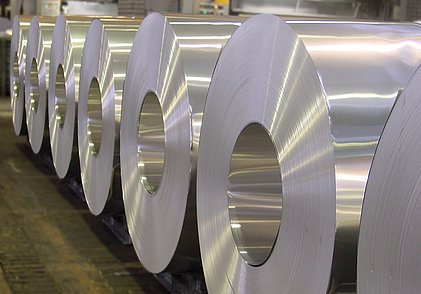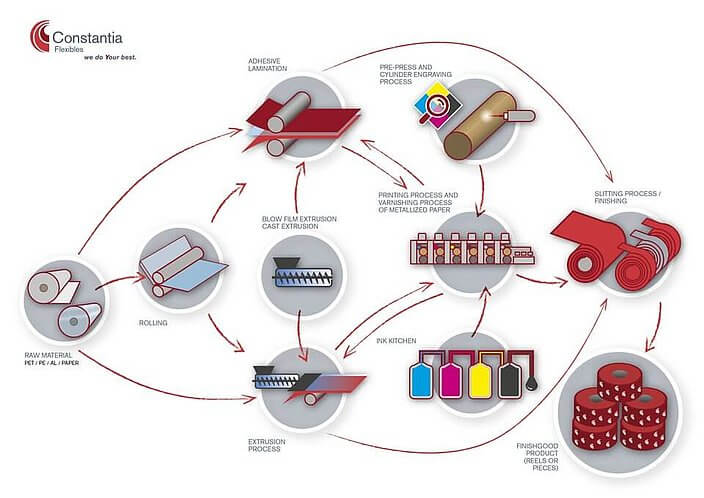
Alu Technology
Alu based production technology
Get in TouchStep. 1 Aluminum rolling
Rolling
On our 5 rolling mills we do cold rolling of base material (alu with gauge of 0,6 mm) down to thicknesses of 120 to 6,3 microns for various applications within our strategic business units dairy & food, pharma and alufoil container systems. The produced foil material within a range of 600 up to 1800 mm width is either internally converted, supplied to subsidiaries, or sold to external converters.
Step. 2 Basic converting
Lacquering
Based on multi-lacquering technology the foil material gets pre converted with self developed heat seal lacquers and print primers and is being prepared for printing and further converting. In order to meet the high environmental requirements at Teich mainly water based on environment-friendly lacquers are used which are all supplied by our internal competence and R&D centre for lacquers.
Laminating
Applying an adhesive on the foil material and attaching a second reel material such as foil, film or paper laminates are produced (e.g. alu/paper, alu/film) as they are used for confectionery. Repeating this process with an already produced laminate multi layer materials are produced (e.g. alu/paper/alu) as they are used for butter wrappers or waffle foil. At Teich following laminating technologies are available: dry lamination, wet lamination and wax lamination.
Extrusion coating
With a die melted polymer is applied on the base material (alu foil) that is used as sealing layer for various kinds of lidding material. Due to variation of the used granules the sealing layer can be adapted to type of polymer used for the plastic cup. Based on the coextrusion principle several film layers can be applied in one step generating a kind of "sandwich-coating".
Step. 3 Printing
Rotogravure
Foil material as well as laminates are printed with engraved steel core cylinders and solvent based inks. The design is engraved into a copper layer on the cylinders which are then chrome plated – the excessive colour on the surface is removed with a doctor blade so that only the ink in the engraved cells remains and prints on the substrate. On our rotogravure machines we can print designs consisting of up to 10 colours including back side printing facilities – additionally further converting (such as hotmelt, cold seal or over lacquering) is possible in line.
UV-Flexo printing
Foil material and laminates are printed with photopolymer clichés and UV-curable inks which are environment-friendly due to solventless application. The design is printed with increased elements on the cliché that are coloured with an anilox roller with doctor blade system. Due to the high resolution of 70 lines per cm also photo realistic designs can be printed in quality comparable to rotogravure printing. On our UV-Flexo printing machines we can print designs consisting of up to 8 colours. Due to an in line rotogravure unit further converting based on solventless lacquer systems – either on front side or back side – is possible.
Flexography
Flexographic printing, or flexography, is a direct, high-pressure, relief printing process on a rotary web press. It uses flexible printing plates or endless rubber sleeves and low-viscosity, solvent-based printing inks. ‘Direct’ means the ink is transferred directly from the printing plate to the material being printed. ‘Relief’ means printing area is in 3D relief. Flexography is a very popular technique for printing packaging made of plastic, paper, card, cardboard, etc. It’s also used for products such as adhesive films, insulating paper, carbon-backed paper, paper napkins and wallpaper.
A printing unit on a flexographic press is generally a bank of rollers. An anilox roll picks up a controlled amount of ink, a doctor system wipes off excess ink from the anilox roll, before it transfers the ink to the print plate. The print plate, mounted on the the print cylinder, transfers the ink to the web of paper or other material being printed. The web runs between the print plate and an impression cylinder, keeping the contact pressure constant. Today’s flexographic presses generally have between 4 and 10 printing units, arranged either in sequence or as satellites around a central cylinder.
Digital
Digital Printing is the process of making prints directly from an electronic file. The artwork is created on a computer and directly printed onto the substrate. Digital printing is an alternative to traditional printing methods such as flexography, gravure, and others. The process eliminates most of the steps that are needed for traditional printing methods such as colour proofs, producing printing plates and mounting them on a cylinder.
The digital process is more effective for medium and shorter print runs. It is possible to print what you want when you need it thanks to digital printing. The fast time to market is a big advantage for digital printing.
Constantia has already made investments in digital UV Inkjet printing for the Pharma market. Further investments will follow as digital printing technology evolves.
Step. 4 Finishing
Slitting
With our slitting machine we cut our reels into narrower lanes and reel diameter according to customer demands to ensure that it fits to our customers´packaging lines.
Deep drawing
Similar to die cutting at the deep drawing press containers are formed out of the converted reel material with a special tool consisting of stamp and die. Shape and size of the containers are up to customers requirements – the most common shapes and sizes are available as standard tools.
Die cutting
With a cutting tool consisting of stamp and die the lids are pressed out of the converted reels. The cutting tools are individually made according to the required shape – the most common shapes are available as standard tools. Additionally we can do in line embossing of the lids with all various kinds of embossing designs. As a special application also sectional embossed or deep drawn shapes are possible.
Reel cutters
Reel cutters slit the web longitudinally into two or more narrower reels. The cutting process splits up the huge rolls that come off the printing press into custom sizes for the customer’s packaging process. This can involve the size of the inner sleeves, the winding angle and direction and the maximum reel diameter. In the cutting process, the web passes at high speed between sharp, rotating upper and lower knives positioned to cut the precise widths required.


